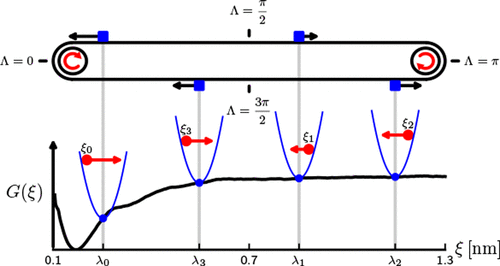当前位置:
X-MOL 学术
›
J. Chem. Theory Comput.
›
论文详情
Our official English website, www.x-mol.net, welcomes your
feedback! (Note: you will need to create a separate account there.)
The Conveyor Belt Umbrella Sampling (CBUS) Scheme: Principle and Application to the Calculation of the Absolute Binding Free Energies of Alkali Cations to Crown Ethers
Journal of Chemical Theory and Computation ( IF 5.7 ) Pub Date : 2020-03-10 , DOI: 10.1021/acs.jctc.9b00998 David F. Hahn 1 , Rhiannon A. Zarotiadis 1 , Philippe H. Hünenberger 1
Journal of Chemical Theory and Computation ( IF 5.7 ) Pub Date : 2020-03-10 , DOI: 10.1021/acs.jctc.9b00998 David F. Hahn 1 , Rhiannon A. Zarotiadis 1 , Philippe H. Hünenberger 1
Affiliation

|
We recently introduced a method called conveyor belt (CB) thermodynamic integration (TI) for the calculation of alchemical free-energy differences based on molecular dynamics simulations. In the present work, the CBTI approach is generalized to conformational free-energy changes, i.e., to the determination of the potential of mean force (PMF) along a conformational coordinate ξ of interest. The proposed conveyor belt umbrella sampling (CBUS) scheme relies on the parallel simulation of K replicas k = 0,1, ..., K – 1 of the system, with K even. For each replica k, the instantaneous value of ξ is restrained to an anchor value λk. The latter anchor points are equally spaced along a forward-turn-backward-turn path (i.e., a CB) between two extreme values defining the ξ-range of interest. The rotation of the CB is controlled by a variable Λ (range from 0 to 2π) which evolves dynamically along the simulation. The evolution of Λ results from the forces exerted by the restraining potentials on the anchor points, taken equal and opposite to those they exert on the replicas. Because these forces tend to cancel out along the CB, the dynamics of Λ is essentially diffusive, and the continuous distribution of ξ-values sampled by the replica system is automatically close to homogeneous. The latter feature represents an advantage over direct counting (DCNT) and traditional umbrella sampling (TRUS), shared to some extent with replica-exchange umbrella sampling (REUS). In this work, the CBUS scheme is introduced and compared to the three latter schemes in the calculation of 45 standard absolute binding free energies. These correspond to the binding of five alkali cations to three crown ethers in three solvents. Different free-energy estimators are considered for the PMF calculation, and the calculated values are also compared to those of a previous study relying on an alchemical path, as well as to experimental data.
中文翻译:

输送带伞采样(CBUS)方案:碱性阳离子与冠醚绝对结合自由能的计算原理和应用
我们最近引入了一种称为传送带(CB)热力学积分(TI)的方法,用于基于分子动力学模拟计算炼金术自由能差异。在当前的工作中,CBTI方法被推广到构象自由能的变化,即确定沿着感兴趣构象坐标ξ的平均力(PMF)的潜力。提出的输送带伞式采样(CBUS)方案依赖于系统的K个副本k = 0,1,...,K – 1的并行仿真,偶数为K。对每个副本ķ,ξ的瞬时值被限制到锚定值λ ķ。后面的锚点在定义感兴趣的ξ范围的两个极值之间沿着前进-后退-转弯路径(即CB)等距分布。CB的旋转由变量Λ(范围从0到2π)控制,该变量Λ在模拟中动态变化。Λ的演化是由约束电位在锚点上施加的力导致的,这些力取与它们在副本上施加的力相等且相反。由于这些力倾向于沿CB抵消,因此Λ的动力学本质上是扩散性的,并且由副本系统采样的ξ值的连续分布自动接近均质。后一特征代表了优于直接计数(DCNT)和传统伞式抽样(TRUS)的优势,后者在某种程度上与副本交换伞式抽样(REUS)共享。在这项工作中 引入了CBUS方案,并将其与后三个方案进行比较,计算出45个标准的绝对束缚自由能。这些对应于在三种溶剂中五个碱性阳离子与三个冠醚的结合。在计算PMF时会考虑使用不同的自由能估计量,并且还将计算出的值与以前的研究(依赖于炼金术的路径)以及实验数据进行比较。
更新日期:2020-04-24
中文翻译:

输送带伞采样(CBUS)方案:碱性阳离子与冠醚绝对结合自由能的计算原理和应用
我们最近引入了一种称为传送带(CB)热力学积分(TI)的方法,用于基于分子动力学模拟计算炼金术自由能差异。在当前的工作中,CBTI方法被推广到构象自由能的变化,即确定沿着感兴趣构象坐标ξ的平均力(PMF)的潜力。提出的输送带伞式采样(CBUS)方案依赖于系统的K个副本k = 0,1,...,K – 1的并行仿真,偶数为K。对每个副本ķ,ξ的瞬时值被限制到锚定值λ ķ。后面的锚点在定义感兴趣的ξ范围的两个极值之间沿着前进-后退-转弯路径(即CB)等距分布。CB的旋转由变量Λ(范围从0到2π)控制,该变量Λ在模拟中动态变化。Λ的演化是由约束电位在锚点上施加的力导致的,这些力取与它们在副本上施加的力相等且相反。由于这些力倾向于沿CB抵消,因此Λ的动力学本质上是扩散性的,并且由副本系统采样的ξ值的连续分布自动接近均质。后一特征代表了优于直接计数(DCNT)和传统伞式抽样(TRUS)的优势,后者在某种程度上与副本交换伞式抽样(REUS)共享。在这项工作中 引入了CBUS方案,并将其与后三个方案进行比较,计算出45个标准的绝对束缚自由能。这些对应于在三种溶剂中五个碱性阳离子与三个冠醚的结合。在计算PMF时会考虑使用不同的自由能估计量,并且还将计算出的值与以前的研究(依赖于炼金术的路径)以及实验数据进行比较。









































 京公网安备 11010802027423号
京公网安备 11010802027423号